Gaul › Saint Patrick » Ancient origins
Articles and Definitions › Contents
- Gaul › Antique Origins
- Saint Patrick › Who Was
Ancient civilizations › Historical and archaeological sites
Gaul › Antique Origins
Definition and Origins
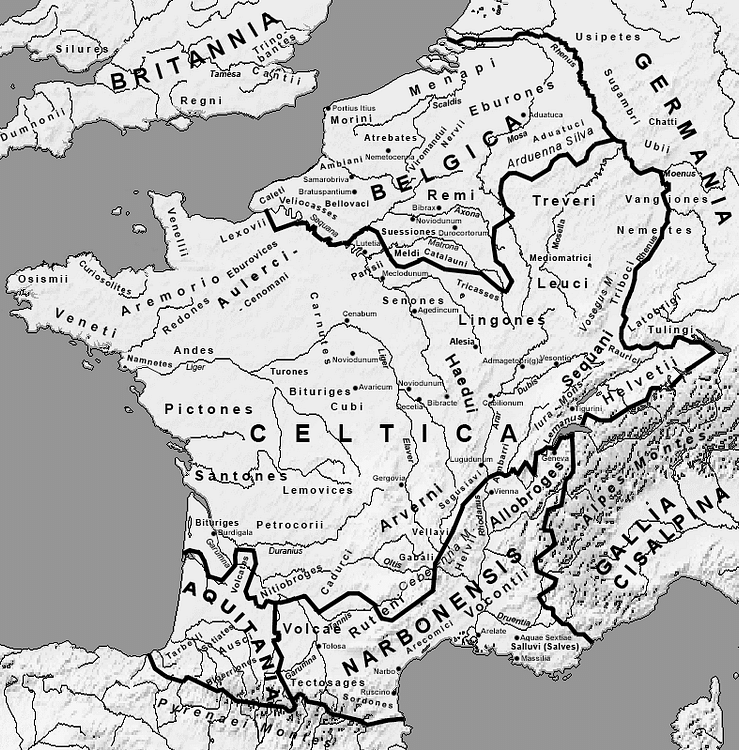
Gaul (Latin Gallia, French Gaule) is the name given by the Romans to the territories where the Celtic Gauls (Latin Galli, French Gaulois) lived, including present France, Belgium, Luxemburg and parts of the Netherlands, Switzerland, Germany on the west bank of the Rhine, and the Po Valley, in present Italy. The ancient limits of Gaul were the Rhine River and the Alps on the east, the Mare Nostrum (Mediterranean Sea), the Po Valley and the Pyrenees on the south, and the Atlantic Ocean on the west and North. Before the Roman conquest by Julius Caesar (58-51 BC), the name “Gaul” corresponded to a cultural and military area founded on a common religion and federations of peoples who though that they had a common origin. This common origin probably dates back to 8th century, when migrants groups of the Bronze Age Urnfield culture spread slowly across the area of the future territory of Gaul. About 390 BC, the Gauls invaded and sacked Rome. In 222 BC, Cisalpine Gaul (the region between the Alps and the Po Valley) was conquered by the Romans. The best description we know about the pre- Roman Gaul is in the first chapter of the Commentarii de Bello Gallico, of Caius Julius Caesar. It is clearly a Roman point of view of the Gallic realities:
All Gaul is divided into three parts, one of which the Belgae inhabit, the Aquitani another, those who in their own language are called Celts, in ours Gauls, the third. All these differ from each other in language, customs and laws. The river Garonne separates the Gauls from the Aquitani; the Marne and the Seine separate them from the Belgae. Of all these, the Belgae are the bravest, because they are farthest from the civilisation and refinement of [our] Province, and merchants least frequently resort to them and import those things which tend to effeminate the mind; and they are the nearest to the Germans, who dwell beyond the Rhine, with whom they are continually waging war ; for which reason the Helvetii also surpass the rest of the Gauls in valour, as they contend with the Germans in almost daily battles, when they either repel them from their own territories, or themselves wage war on their frontiers. One part of these, which it has been said that the Gauls occupy, takes its beginning at the river Rhone: it is bounded by the river Garonne, the ocean, and the territories of the Belgae: it borders, too, on the side of the Sequani and the Helvetii, upon the river Rhine, and stretches towards the north. The Belgae rise from the extreme frontier of Gaul, extend to the lower part of the river Rhine; and look towards the north and the rising sun. Aquitania extends from the river Garonne to the Pyrenaean mountains and to that part of the ocean which is near Spain: it looks between the setting of the sun and the north star.
After Julius Caesar had conquered Gaul, the territorial organization of Gaul as part of the Roman Empire was concluded by Emperor Augustus from 27 to 12 BC: Respecting the ancient organization described by Julius Caesar, Augustus created three Roman Provinces: Gallia Belgica, Gallia Lugdunensis and Aquitania. In the south, the old Roman Provincia, to which Massilia was added, was renamed Gallia Narbonensis. The territories bordering the Rhine River were combined into two military areas, which under Domitian became the provinces of Upper and Lower Germania. For about 200 years the Roman peace ( Pax romana ) was maintained, with the exception of some local revolts and civil troubles. The Germanic incursions of the 3rd century AD marked the end of this epoch.
Saint Patrick › Who Was
Definition and Origins
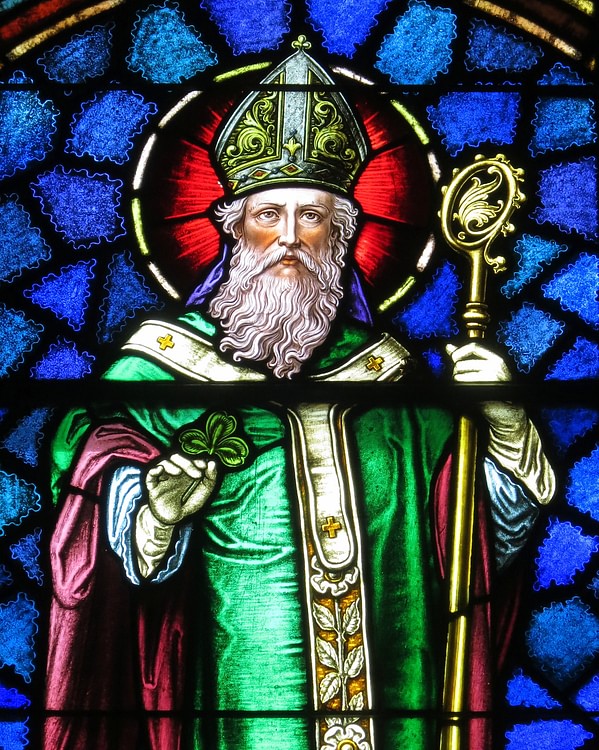
Saint Patrick (5th century CE) is the patron saint of Ireland and one of the most successful Christian missionaries in history.He was a Roman citizen of Britain (known as Patricius) who was captured by pirates at the age of sixteen and sold into slavery in Ireland. He escaped back to Britain, became ordained as a bishop, and returned to the land of his captivity as a missionary in c. 432/433 CE. He is credited with expanding literacy in Ireland through the monastic orders he established, revising and codifying the Brehon Laws, and converting the country to Christianity. He was not the first Christian missionary to Ireland but is the most famous. His influence on the laws and culture of Ireland was enormous as he championed the causes of women, the poor, and slaves while conferring with kings and nobles. His death date is celebrated on 17 March but the year he died, as with his year of birth, is unknown.
EARLY LIFE & CAPTIVITY
Nothing is known of Patrick's early life save what he mentions in his Confession ( Confessio ). He writes that he was born in Bannaven of Taberniae but this location has never been positively identified. Scholars have advanced claims for Dumbarton or Ravenglass in Britain, or regions in Brittany, Scotland, and Wales. His father was a magistrate named Calporn and, according to legend, his mother was Conchessa, a niece of the famous St. Martin of Tours (316-397 CE). When he was sixteen years old, Patrick was captured by pirates and sold into slavery in Ireland. Some accounts, such as that of the writer Probus, mention two women who were captured with him, Darerca and Lupida, referred to as his sisters but Patrick himself makes no mention of them and Probus himself doubts they were blood relations. If they existed, Probus claims, they were `sisters' in faith.
In Ireland, Patrick was sold to a local chieftain named Miliue of Antrim (also known as Miliucc) who sent him out to tend the flocks in the nearby Valley of the Braid. For six years he served Miliue, often herding the flocks nearly naked in all kinds of weather. Writer Thomas Cahill describes the conditions:
The life of a shepherd-slave could not have been a happy one. Ripped out of civilization, Patricius had for his only protector a man who did not hold his own life highly, let alone anyone else's. The work of such shepherds was bitterly isolated, months at at time spent alone in the hills. The occasional contacts, which one might normally seek out, could bring their own difficulties...Like many another in impossible circumstances, he began to pray. He had never before paid attention to the teachings of his religion : he tells us that he didn't really believe in God, and he found priests foolish. But now, there was no one to turn to but the God of his parents (101-102).
Patrick's belief in and reliance on God became stronger by the day. He writes how, "The love and fear of God more and more inflamed my heart; my faith enlarged, my spirit augmented, so that I said a hundred prayers by day and almost as many by night. I arose before day in the snow, in the frost, and the rain, yet I received no harm, nor was I affected with slothfulness. For then the spirit of God was warm within me." He continued on in this way until the night he received a message in a dream.
IN IRELAND ST. PATRICK WOULD CHANGE THE LIVES AND FUTURES OF THE PEOPLE HE HAD ONCE WALKED AMONG AS A SLAVE.
A voice spoke to him saying, "Your hungers are rewarded. You are going home. Look, your ship is ready." Patrick immediately set out on foot toward the sea, crossing over 200 miles as a fugitive slave to the coast, most likely Wexford. He tried to book passage on a merchant ship heading to Britain but was refused. He then recounts how he prayed for help and the captain of the ship sent for him to come on board. Three days later they landed on the shores of Britain.
PATRICK'S ORDINATION & RETURN
The spot where Patrick landed in Britain is unclear but he describes disembarking with the Irish sailors onto a land of desolation. It took them two weeks to cross a desert-like landscape during which time Patrick saved them from starvation.When they taunted him about his faith being of little use in finding food or water he encouraged them to pray and trust in God;and shortly a herd of pigs appeared to provide for them. He traveled on with the sailors until they reached a town from which he then went on alone and finally came to his home where he was welcomed back by his parents. Cahill writes, "But Patricius is no longer a carefree Roman teenager. Hardened physically and psychologically by un-sharable experiences, hopelessly behind his peers in education, he cannot settle down" (105). Still, he remained at the home of his parents until another visionary dream moved him to leave.
He dreamed that a man he had known in Ireland named Victor came to him carrying letters:
And there I saw a vision during the night, a man coming from the west; his name was Victorious, and had with him many letters; he gave me one to read, and in the beginning of it was a voice from Ireland. I then thought it to be the voice of the inhabitants of Focluit Wood, adjoining the western sea; they appeared to cry out in one voice, saying, `Come to us, O holy youth, and walk among us.' With this I was feelingly touched, and could read no longer. I then awoke.
Patrick left his family, over their protests, and traveled to Gaul where, after years of study, he was ordained a bishop at Auxerre. He could have remained in Gaul or returned to his family in Britain but Patrick believed he had a mission to the people he had left behind; and so he returned to Ireland. Before leaving, he made confession to another At Auxerre of a sin he carried on his conscience from youth. The nature of this sin is never mentioned but his confessor later brought it to light, requiring Patrick to defend himself and resulting in his famous Confession.
When he arrived in Ireland he was hardly welcomed. He writes how, when he landed (probably at Wicklow) the people were so hostile to him he quickly moved on north. Patrick knew the language of the Irish from his years in captivity and, just as importantly, knew their beliefs. He seems to have been adept at sharing the Christian message in a way he knew the people would best understand and receive. There has been much written about the famous episode in which Patrick explains the Trinity using a shamrock, for instance, and historians, scholars, and theologians have debated whether the event actully happened. Whether that event ever took place is not as important as what the story says about Patrick's method of reaching the people. The concept of the triple deity, a supernatural being represented in three aspects, was well known in Ireland. The ancient goddesses Eriu, Fodla, and Banba, although not written about until the 11th/12th centuries CE, were known through oral tradition for centuries as the three sisters who gave their names to Ireland. They were, in effect, three aspects of the spirit of the land. The goddess Brigid, likewise, was represented as three sisters who embodied the life force through healing, creativity, and productivity. The story of St. Patrick and the shamrock would have reflected how St. Patrick drew upon the spiritual and physical world the Irish knew to explain the gospel in familiar terms.
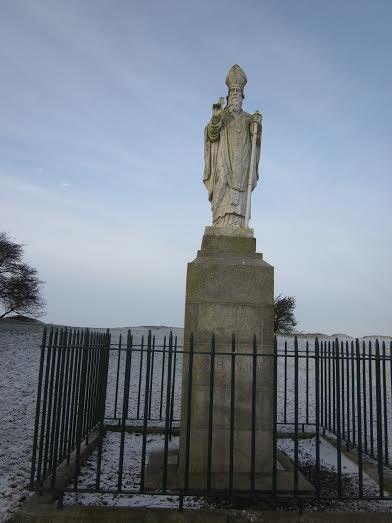
Statue of St. Patrick, Hill of Tara
PATRICK'S MISSION
St. Patrick was not the first missionary to Ireland nor was Ireland a pagan wilderness when he arrived. Palladius was the first Christian missionary to Ireland and the first bishop. There were already Christians in Ireland upon Patrick's arrival and Christian communities were well established. Patrick did not so much bring Christianity to the island as popularize it and, according to legend, he began with a flourish which has become one of the best known tales concerning him.
He arrived in either 432 or 433 CE and announced the coming of Christianity dramatically. The pagan festival of Ostara was to be celebrated and the High King of Tara had decreed that no fires should be lit in the land before the great bonfire on the Hill of Tara initiated the holiday. Patrick and his followers climbed the Hill of Slane, directly across from Tara, and lit their own bonfire. When the king saw the flames, in defiance of his ordinance, he sent soldiers to put it out and arrest whoever was involved. By chanting the poem now known as Saint Patrick's Breastplate (a lorica also known as Faed Fiada or Deer's Cry ) Patrick and his followers were able to pass through the soldiers undetected, as though they were a herd of deer.
They came to Tara where Patrick defeated the druids in debate and won the right to preach to the court of the king Laoghaire and his queen and chietains. At this same time the soldiers who had been sent to arrest Patrick appeared, reporting that they could not extinquish Patrick's fire. The story concludes with many of the court converting to Christianity and the king, who refused, respecting Patrick well enough to free him to continue his mission.
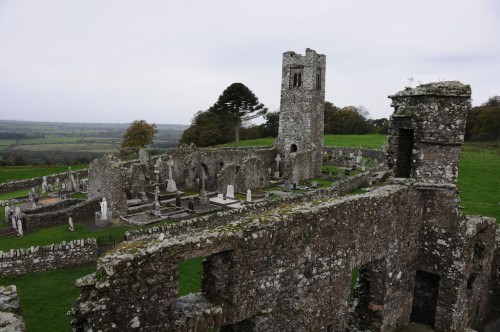
Slane Abbey
The theory suggested by scholar TF O'Rahilly that there were two St. Patricks - one Palladius and the other Patrick whose stories were combined - is untenable in that Palladius' mission never generated the kinds of stories and legends which Patrick's did nor does the archaeological evidence support the kind of wide-spread Christian conversion during Palladius' mission that it does following Patrick's. Palladius came as a representative of the Christian church to convert the pagans;Patrick came as a friend of the people to introduce them to a friend who had helped him when he needed help most. Cahill comments that Patrick "transmuted [the Irish people's] pagan virtues of loyalty, courage, and generosity into the Christian equivalents of faith, hope, and charity. But, though this singular display of virtue would have made friends, it would not necessarily have won converts - at least, not among a people as stubborn as the Irish" (124). St. Patrick succeeded in his mission by touching the people through a deep respect and love for them and a culture he had come to embrace. Cahill writes:
In becoming an Irishman, Patrick wedded his world to theirs, his faith to their life... Patrick found a way of swimming down to the depths of the Irish psyche and warming and transfroming Irish imagination - making it more humane and more noble while keeping it Irish. No longer would baptismal water be the only effective sign of a new life in God. New life was everywhere in rank abundance, and all of God's creation was good (115).
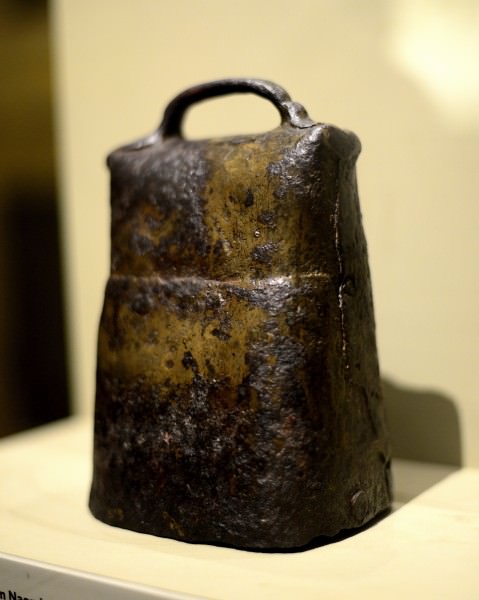 BELL OF ST. PATRICK, IRELAND
BELL OF ST. PATRICK, IRELAND

LATER LIFE & LEGACY
Patrick would go on to found Christian communities throughout Ireland, most notably the church in Armagh which became the ecclesiastical capital of the churches of Ireland and where Patrick would write his Confession, codify the Brehon Laws, and finally retire. The Celtic Church he founded, like that of the missionary Columba's in Scotland after him, differed in a number of ways from the church of Rome, most notably in its inclusion of women in church hierarchy, the dating of Easter, tonsure of monks, and the liturgy. Scholars are divided on how significant these differences really were and most now reject the claim that the Celtic Church was very different in vision than the Roman Catholic.
However that may be, in his time in Ireland St. Patrick changed the lives and futures of the people he had once walked among as a slave. Whatever successes the earlier missionaries such as Palladius, Ailbe, Declan, Ibar, and Ciaran had won, none advanced the causes of literacy, spirituality, and the dignity of the individual as Patrick did. Historian Murray Pittock cites the 19th/20th century CE scholar Eoin MacNeill's view that the Irish were "descended from a pagan warrior civilization who, when converted to Christianity, transformed Ireland into a unique island of sanctity and learning" which redefined the Celt and Celtic society (76). The monasteries he founded or encouraged became centres of literacy and learning, sprawling universities devoted to knowledge, which would in time serve to collect and preserve the written record of western civilization after the fall of Rome. The Roman Empire had never invaded Ireland and so the land was relatively unaffected by its fall. In the Christian monasteries of Ireland the great written works of the past were copied and preserved for future generations. Through his vision and mission, St. Patrick changed not only Ireland, but the world.
LICENSE:
Article based on information obtained from these sources:with permission from the Website Ancient History Encyclopedia
Content is available under License Creative Commons: Attribution-NonCommercial-ShareAlike 3.0 Unported. CC-BY-NC-SA License